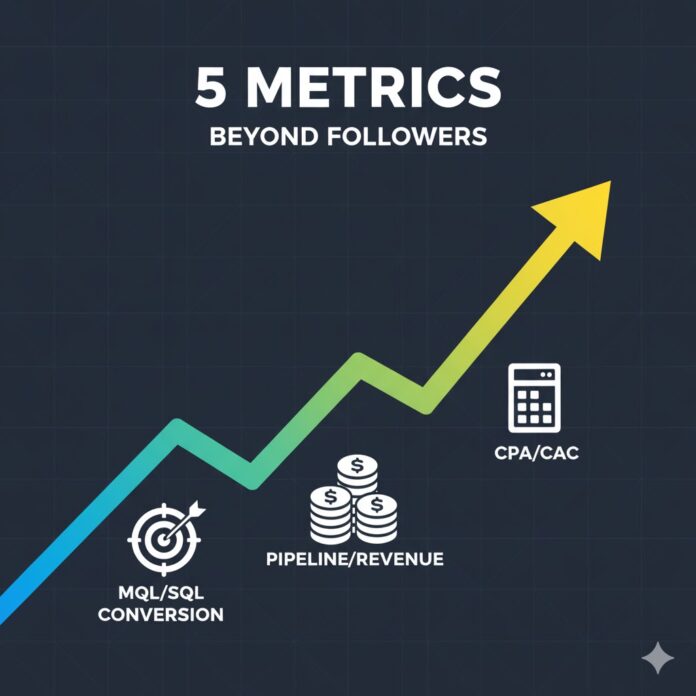
🚀 Beyond the Follower Count: Which 5 Core Metrics You Should Actually Track in Your Weekly Marketing Report for Sustainable Career Growth
In today’s fast-paced digital marketing landscape, it’s easy to get lost chasing vanity metrics like follower counts and likes. While they offer a quick ego boost, they rarely tell the whole story of your true impact or your sustainable career growth as a marketer.
If you want to move from being a tactical executioner to a strategic marketing leader, your weekly report needs to evolve. It’s time to shift your focus to metrics that directly connect marketing efforts to business goals and revenue, thereby proving your value and paving the way for your next promotion.
Here are the 5 core, SEO-rich metrics you must track in your weekly report to demonstrate strategic thinking and secure your professional future:
1. 🎯 Marketing Qualified Leads (MQLs) to Sales Qualified Leads (SQLs) Conversion Rate
This is the ultimate measure of lead quality, not just quantity.
- What it is: The percentage of leads your marketing team identifies as “sales-ready” (MQLs) that the sales team accepts and begins actively working (turning them into SQLs).
- Why it Matters for Your Career: High conversion shows you’re not just generating traffic—you’re generating valuable, high-intent prospects. A consistently high MQL-to-SQL rate demonstrates alignment between marketing and sales, a key trait of a strategic marketing manager or director.
2. 💰 Marketing’s Contribution to Pipeline/Revenue
Stop reporting on blog views; start reporting on dollars.
- What it is: The monetary value of the sales pipeline (potential future revenue) or actual closed-won revenue that originated directly from your marketing efforts. This includes leads generated through SEO content, paid campaigns, or email nurturing.
- Why it Matters for Your Career: This metric speaks the language of the executive suite: ROI and business growth. When you can confidently say, “My team contributed $X to the pipeline this week,” you become indispensable. It’s the cornerstone of a performance marketing strategy.
- Key Focus Areas: Track new opportunities created from organic search, specific campaign performance, and lead nurturing funnel success.
3. 📉 Cost Per Acquisition (CPA) / Customer Acquisition Cost (CAC)
Efficiency and profitability are hallmarks of a senior marketer.
- What it is: The total cost (marketing spend, salaries, overhead) required to acquire one new, paying customer. Ideally, you report this broken down by channel (e.g., CPA for Google Ads, CPA for organic search).
- Why it Matters for Your Career: Lowering CPA while maintaining quality leads shows budgetary discipline and optimization mastery. It proves you can scale growth profitably, which is a critical skill for any VP of Marketing or C-level executive.
- Strategic Insight: Focus your weekly analysis on which channels (e.g., high-ranking SEO keywords) are delivering the lowest CPA.
4. 📈 Content Performance: Goal Completions per Session
Move beyond ‘Time on Page’—track meaningful engagement.
- What it is: This metric measures how often a user completes a desired action (a “Goal”) after visiting a piece of content. Goals can be downloading an e-book, signing up for a newsletter, or clicking a call-to-action (CTA) button.
- Why it Matters for Your Career: It demonstrates your content is effective and converting. If your latest blog post on “SEO strategies” generates a high number of e-book downloads, you’ve proven the content’s business utility, not just its readability. This elevates your status as a content strategist.
- Tracking Focus: Compare this rate across different content formats (guides vs. checklists vs. case studies) to guide future content investments.
5. 🔁 Customer Lifetime Value (CLV) to CAC Ratio
The long game is where true value lies.
- What it is: The ratio comparing the total revenue a customer is expected to generate over their relationship with the company (CLV) against the cost to acquire them (CAC). A healthy ratio is typically 3:1 or higher.
- Why it Matters for Your Career: A strong CLV:CAC ratio shows you are acquiring customers who are profitable and loyal. It proves your marketing efforts attract the right kind of customer who stays longer and spends more. This level of insight signals a business-minded marketer ready for leadership roles.
- Weekly Action: While CLV is a long-term metric, track how your weekly customer cohorts (new sign-ups this week) are trending on early engagement and retention metrics, which are strong CLV predictors.
Key Takeaway for Your Next Promotion
Stop using your weekly report as a simple task list. Use it as a narrative to tell the story of how your marketing efforts drive predictable, profitable business growth. By focusing on these 5 core strategic metrics, you shift the conversation from “What did you do?” to “What value did you create?”, positioning yourself as the next marketing leader the company needs.





















 🔥 Limited Time: Get 55% OFF All Plans - Ends in:
🔥 Limited Time: Get 55% OFF All Plans - Ends in: